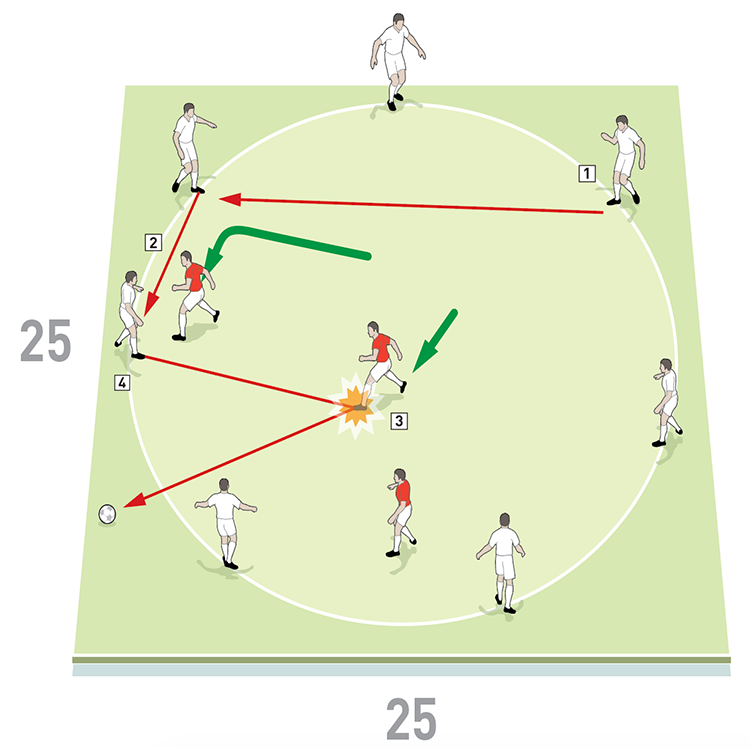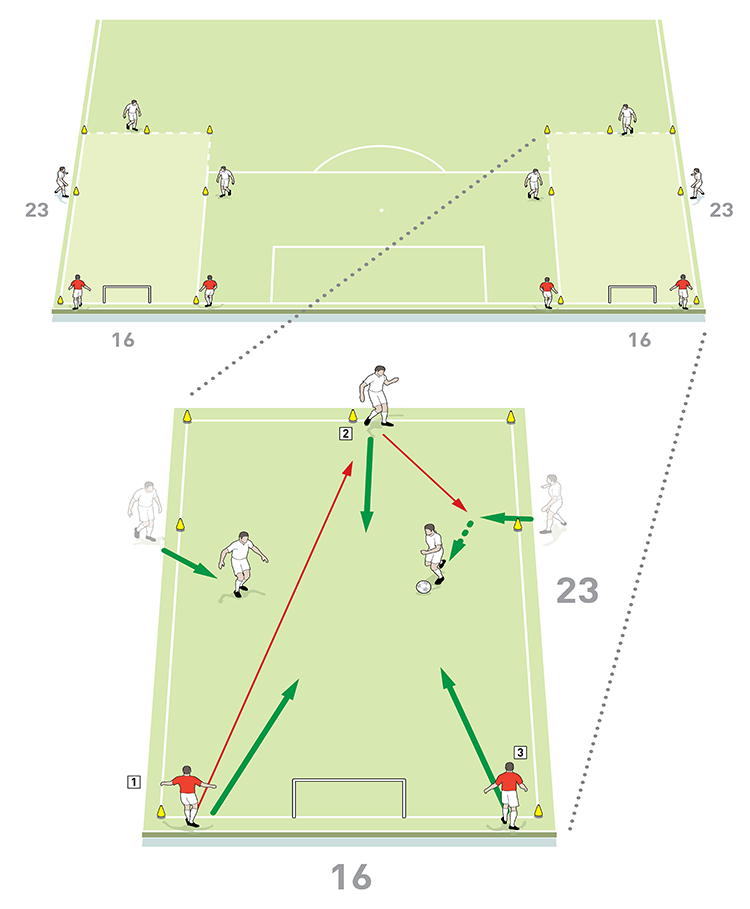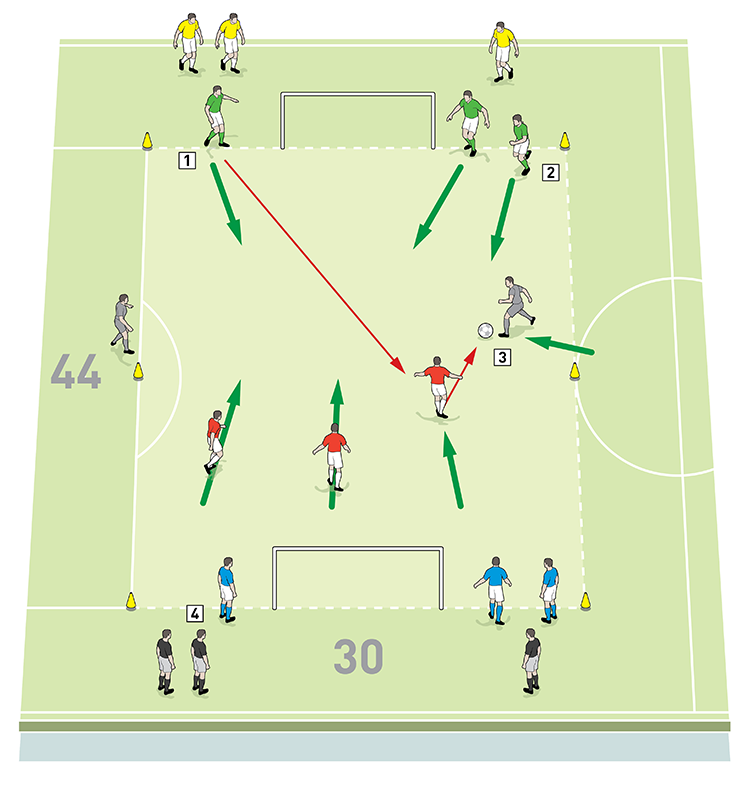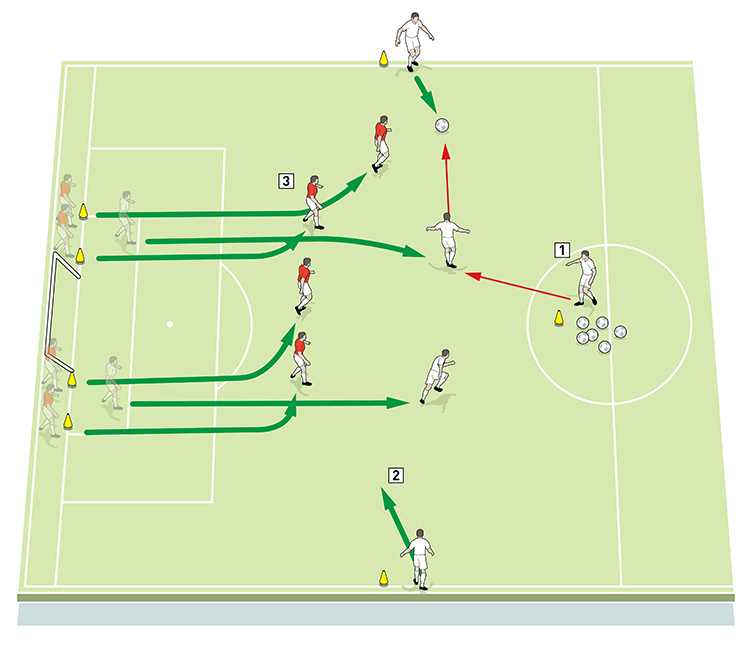




OUR BEST EVER OFFER - SAVE £100/$100
JOIN THE WORLD'S LEADING PROFESSIONAL DEVELOPMENT PROGRAMME
- 12 months membership of Elite Soccer
- Print copy of Elite Player & Coach Development
- Print copy of The Training Ground
You are viewing 1 of your 1 free articles
Compactness when defending overloads
This session teaches your players how to defend as a unit and how to delay an attack, even when faced by attackers who outnumber you. It works on improving individual defensive skills and reinforces the need for speed to stop an attack.
| Area | Full pitch |
| Equipment | Balls, cones, bibs, 4 small goals, 3 large goals |
| No. of Players | 20 |
| Session Time | Total: 60mins, Warm-up: 15mins, 2v3: 10mins, 3v4: 15mins, 4v5: 20mins |
This session teaches your players how to defend as a unit and how to delay an attack, even when faced by attackers who outnumber you. It works on improving individual defensive skills and reinforces the need for speed to stop an attack, but by the end of the session it will have encouraged your defence to keep its shape and your players to support one another through good communication, always reacting to the position of the ball as it moves around the pitch – when one defender goes to the ball the other defenders move to cover the space.
The beauty of this session is that although it is aimed at improving your defence against an attacking overload, it also works as a good test for your offensive players too, encouraging them to keep possession and take advantage of their numerical superiority.
What do I get the players to do?
Warm-up rondo
Begin by setting up a 25-yard circle for a high intensity warm-up rondo, as shown [1]. Position seven players around the edge and get them to play a possession game by passing the ball between themselves while keeping their shape around the circle.
Have three chasers in the centre who must pressure the outside players in order to intercept the ball. When a chaser wins the ball, he swaps places with the outside player who lost possession. Play for 15 minutes.
If you have 20 players, run two warm-ups at the same time.
1

2. The red chasers must try to win the ball by pressing and then kick it out of the circle
3. Here the chasers have closed off all safe passes, forcing a poor pass that is intercepted
4. The outside player who lost the ball must swap places with the chaser who won it and plays continues
Part 1: Defending 2v3
For the first part of the session set up two 23x16-yard areas, one on either side of the penalty box. Each area should contain one mini goal, as shown [2a]. It is the job of the two defenders to prevent the three attackers from scoring, while the attackers must try to make use of their overload. Play starts with a defender playing the ball into the feet of the furthest attacker, as shown [2b]. As soon as the first attacker touches the ball play goes live and the defenders must quickly push out to prevent the attackers from scoring. Their speed out to the ball is vital for the success of this practice, as is their bodyshape and balance when approaching the attackers. The defenders must also communicate with one another. Play for 10 minutes.
If you have 20 players this can be set up in all four corners of the pitch and run simultaneously.
2a/2b

2. The game is live as soon as the first attacker has touched the ball. Attackers should use their numerical advantage
3. Defenders must use speed to get up the pitch and good decision-making and communication to prevent the attackers from scoring
Part 2: Defending 3v4 wave game
Set up an area of 44x30 yards between the edge of your penalty area and the centre circle, using two full-size goals, as shown [3]. Position four teams of three to enter the pitch in waves from the sides of the goals, with a fifth team (the reds) starting on the pitch. A supporting striker is stationed on each side of the area.
Play starts with the ball being pinged up the pitch to the red team, which attacks the first wave of defenders (the greens) and attempts to score in the goal the greens are defending. As soon as the first red player touches the ball, the greens rush out to defend, but one of the supporting strikers joins in to give the red attackers a 4v3 advantage. After the ball has gone dead, the greens become attackers and play now goes in the opposite direction with a fresh attack. Each wave of defenders turn to attack the opposite end once the ball has gone dead, receiving a starting pass from the next wave of defenders. A supporting striker comes on to give the attackers the overload each time. Play for 15 minutes.
3

2. As soon as the reds touch the ball, play is live and the greens quickly rush out to defend their goal
3. A neutral striker joins the attackers to give them a 4v3 overload
4. When the attack goes dead, the greens become attackers and the blues are the new defenders. Play starts again with a ball played out from the defenders. Repeat with each new wave of players, alternating the end of attack
Part 3: Defending 4v5
For the final part of the session, set up in one half of a full pitch with four defenders, two on each side of a full-size goal, as shown [4]. An attacker is positioned on each side of the pitch and two more start in the six-yard box. On the blow of a whistle, an attacker in the centre circle starts play by passing the ball forward towards one of his team-mates, both of whom are pushing quickly out of the area to receive the pass. They are supported by the wide attackers who move in from the sides to join the attack. At the same time the defenders quickly squeeze out of the penalty area as a back four, staying compact and trying to move as a block to stand in the path of any attack. They must cover the distance at speed but keep their shape by talking to one another. If they are successful they will prevent the attackers from scoring. Play for 20 minutes.
4

2. Attackers at the side join in to give the whites a numerical advantage as they try to score
3. The defenders push out as a compact back four, covering distance at speed and keeping their shape as they move towards the ball to block the attack
What are the key things to look out for?
We look for player understanding of the defensive structure when facing an attack, as overloads are a common occurrence in match play. Defenders must read the situation as individuals working in a team. So as shown in part 3 of the session [see above], if one player goes to the ball, say the left wingback, the other defenders move across – so the central defender would cover the wingback’s position and the other defenders move across to cover the central position.
Individually players must support play, keeping themselves in the correct position to cover the ball and the goal should the attack get past the first defender. Covering the overload player needs good communication between the defenders so any gaps that are created by moving positions are quickly covered.
Related Files
Editor's Picks
Attacking transitions
Deep runs in the final third
Using the goalkeeper in build-up play
Intensive boxes drill with goals
Penetrating the final third
Creating and finishing
My philosophy
Pressing initiation
Compact team movement
Coaches' Testimonials

Alan Pardew

Arsène Wenger

Brendan Rodgers

Carlos Carvalhal

José Mourinho

Jürgen Klopp

Pep Guardiola

Roy Hodgson

Sir Alex Ferguson

Steven Gerrard
Coaches' Testimonials

Gerald Kearney, Downtown Las Vegas Soccer Club

Paul Butler, Florida, USA

Rick Shields, Springboro, USA

Tony Green, Pierrefonds Titans, Quebec, Canada
Join the world's leading coaches and managers and discover for yourself one of the best kept secrets in coaching. No other training tool on the planet is written or read by the calibre of names you’ll find in Elite Soccer.
In a recent survey 92% of subscribers said Elite Soccer makes them more confident, 89% said it makes them a more effective coach and 91% said it makes them more inspired.
Get Monthly Inspiration
All the latest techniques and approaches
Since 2010 Elite Soccer has given subscribers exclusive insight into the training ground practices of the world’s best coaches. Published in partnership with the League Managers Association we have unparalleled access to the leading lights in the English leagues, as well as a host of international managers.
Elite Soccer exclusively features sessions written by the coaches themselves. There are no observed sessions and no sessions “in the style of”, just first-hand advice delivered direct to you from the coach.







